1. Sunrise at Angkor Wat Temple
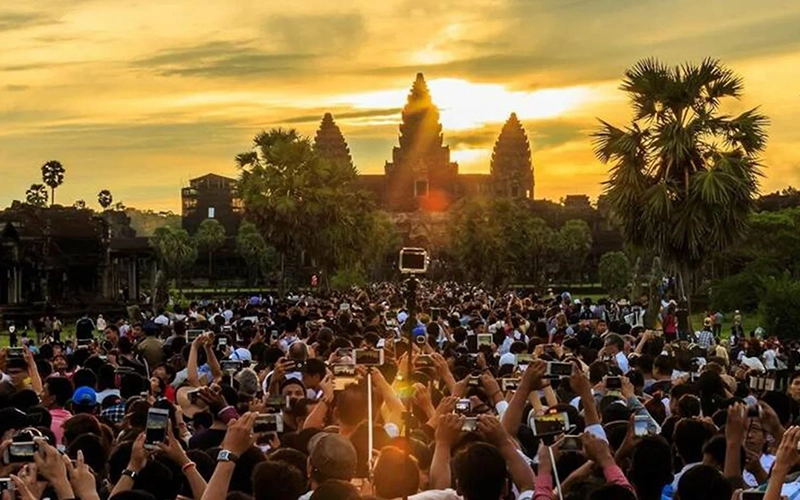 |
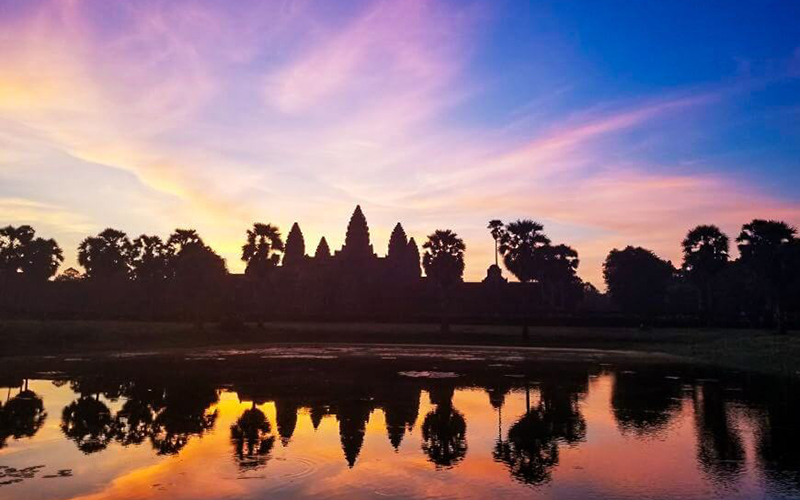 |
Angkor Wat Temple Tour with Sunrise – Witness the Dawn of History in Cambodia
Imagine stepping into the ancient grandeur of Angkor Wat as dawn breaks—a mesmerizing blend of history, spirituality, and dawn-lit splendor. With our Angkor Wat temple tour with sunrise, you’ll embark on an early-morning journey that reveals Cambodia’s spiritual heart under breathtaking dawn light.
Why This Tour Stands Out
- Magical Sunrise Over Ancient Towers: Behold the first rays of light painting Angkor Wat’s reflection pools and spires in warm, golden hues—a sight hailed as one of the world’s most stunning temple sunrises
- Beat the Crowds, Embrace Peace: Tours begin as early as 4:10–4:30 AM, guiding you to quieter viewpoints for a serene and contemplative sunrise experience
- Rich Cultural Journey: After sunrise, continue exploring iconic temple treasures—like Ta Prohm’s jungle-clad towers, Bayon’s stone faces, and Angkor Thom’s storied gateways—with your expert guide sharing untold tales along the way
- Stress-Free Comfort: Enjoy hassle-free hotel pickup and drop-off, air-conditioned transport, bottled water, and a knowledgeable English-speaking guide for a fully immersive experience
2. Kulen Mountain & Waterfall Park
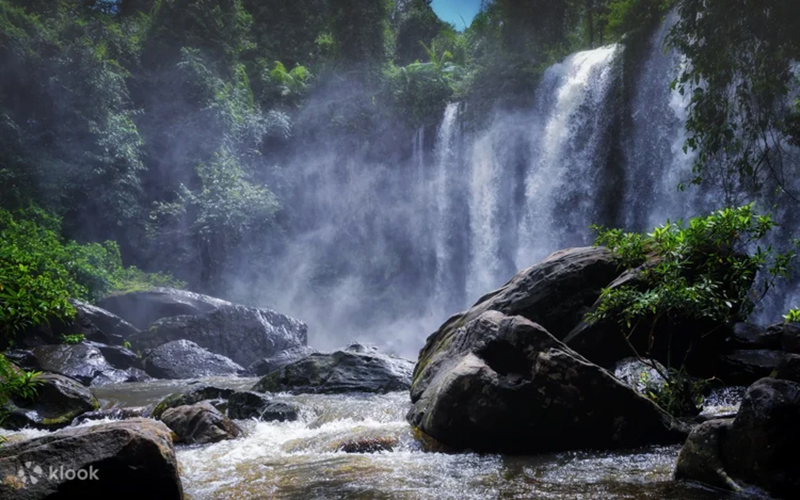 |
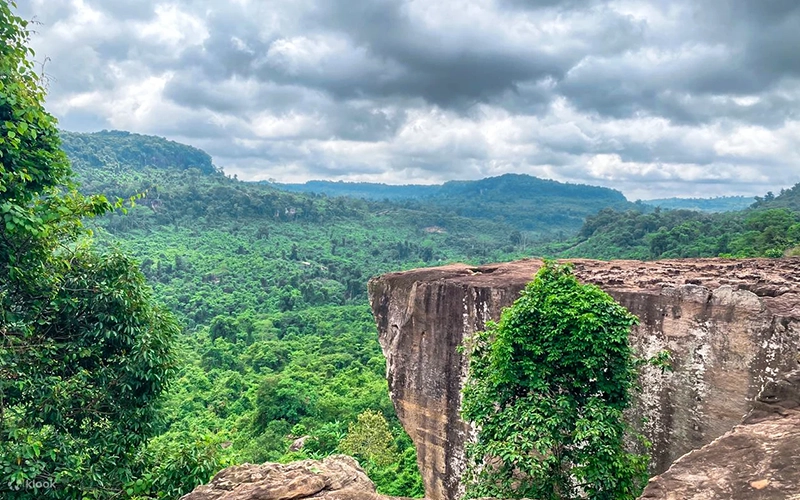 |
- Kulen Mountain Tour – Nature, History & Spiritual Discovery
- Escape the crowds and explore Cambodia’s sacred wilderness on a Kulen Mountain Tour, just a short drive north of Siem Reap. A hidden gem beyond Angkor, Kulen offers ancient spirituality, refreshing waterfalls, and lush forest trails for the adventurous traveler.
Why Kulen Mountain is a Must-Visit
- Birthplace of the Khmer Empire
Phnom Kulen (literally “Lychee Mountain”) was known as Mahendraparvata—the mountain of Great Indra—and is where Jayavarman II declared the founding of the Khmer Empire in 802 CE - A Portal to the Past
Walk the jungle path to Kbal Spean—the Valley of a Thousand Lingas—where ancient riverbed carvings depicting fertility figures remain visible atop sandstone beneath the river’s surface - Sacred Reclining Buddha & Carved Statues
Marvel at the 8-meter tall Preah Ang Thom reclining Buddha sculpted from sandstone, and the haunting Srah Damrei, a pond featuring stone elephants and other animal carvings scattered throughout the valley - Enchanting Waterfalls & Scenic Vistas
Swim beneath two-tiered waterfalls—one 4–10 m high and another 15–25 m tall depending on rainy or dry season flow. The views from forested cliffs overlooking jungle terrain offer immersive natural beauty.
3. Banteay Srei Temple
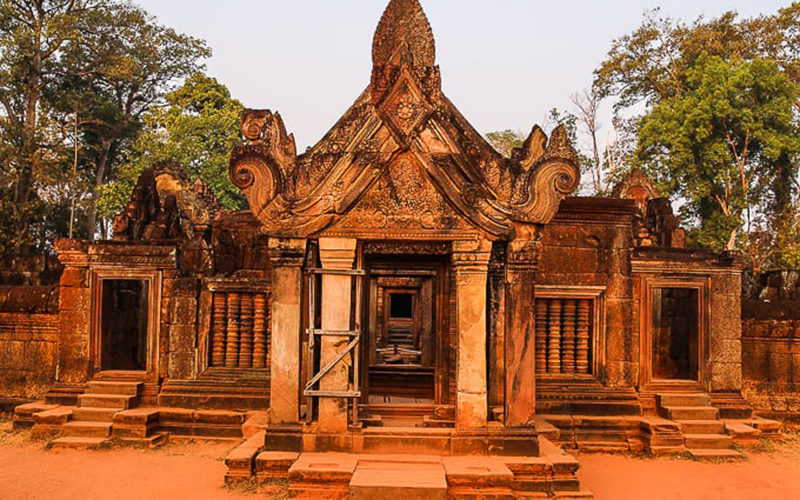 |
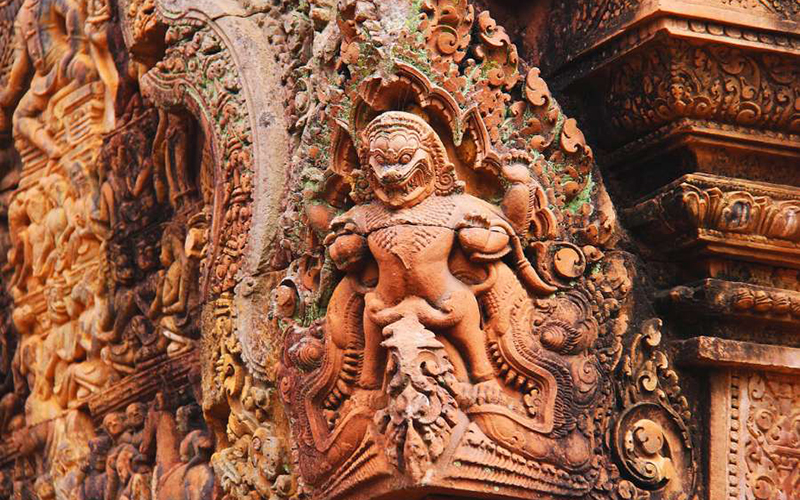 |
Imagine walking through a fairy-tale temple in the gentle light of sunrise, where every pink-toned carving unfolds mythic stories in breathtaking detail. Banteay Srei is not just a monument—it is a whisper of devotion, a meditation in stone, and a heartfelt testament to Khmer artistry.
Banteay Srei—a jewel among Angkorian temples that captivates with its delicate artistry and intimate charm.
Why Banteay Srei Shines Uniquely
- Citadel of Beauty (Citadel of Women)
Built in 967 CE by a Brahmin scholar rather than a king, Banteay Srei stands out for its exquisite craftsmanship on a miniature scale—earning it the name Citadel of Women or Citadel of Beauty - Pink Sandstone & Intricate Detail
Fashioned from rare, fine-grained red sandstone, this temple allows for carvings of sculptural precision unmatched across Angkor. Every arch, wall, and lintel tells a story through richly detailed bas-reliefs. - Masterpieces Carved in Stone
Scenes from the Ramayana, Mahabharata, and Hindu cosmology bring the temple alive—like Shiva taming Ravana under Mount Kailasa, or Indra riding his three-headed elephant Airavata. The artistry is so refined that not a single surface remains unadorned. - Artistic Legacy & Cultural Significance
Banteay Srei represents a turning point in Khmer art—fusing earlier styles with a new decorative flair that influenced future monuments. This private temple was a devotional gem infused with spiritual intent rather than grandeur. - Intimate & Thoughtful Visitor Experience
Located about 25 km northeast of Angkor Wat, the journey to Banteay Srei via rural roads and templeside scenery feels like stepping into a fairy tale. Its compact layout invites quiet appreciation rather than hurried tours. - Conservation & Restoration Achievements
Rediscovered in the early 20th century and expertly restored using anastylosis, Banteay Srei now stands beautifully preserved, protected from environmental and tourist wear through careful conservation
4. Cambodia’s Floating Village
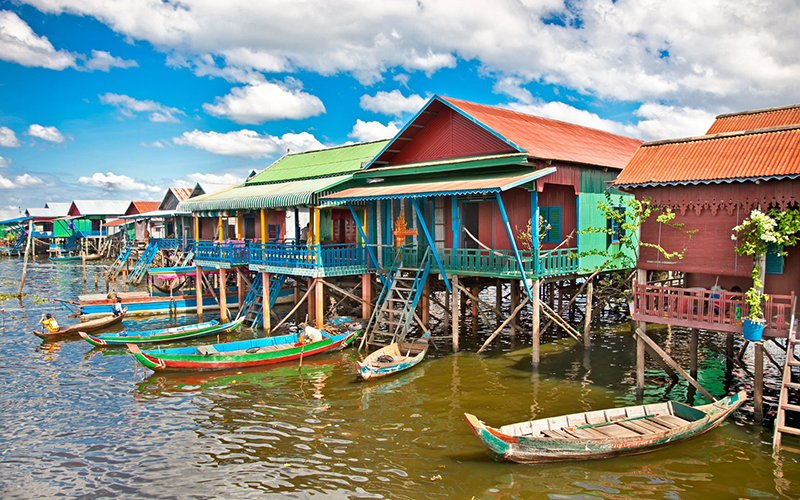 |
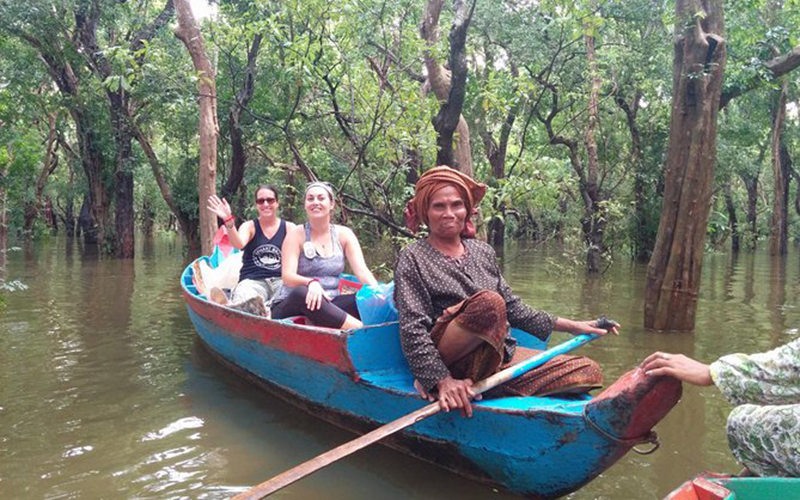 |
Discover Kampong Phluk - Cambodia’s Floating Village
Unforgettable Floating Village Tours
Kampong Phluk, often dubbed a floating village, is a mesmerizing spectacle nestled about 20–30 km southeast of Siem Reap along Tonlé Sap Lake. During the wet season (June–October), rising waters turn the entire village into a watery paradise—nowhere more evocative than its canopy of vibrant stilted houses rising 6–9 meters above the water.
In the opposite season, the dry months (November–April) lower the waters, revealing narrow mud pathways, offering a contrasting glimpse of life adapted to nature’s rhythm.
Authentic Culture & Natural Beauty
Touring Kampong Phluk immerses you into the day-to-day pulse of a resilient fishing community. Glide past floating markets, children paddling to school, and a colorful pagoda filled with murals, expressing a blend of Buddhist and Hindu faiths.
You can also explore the nearby mangrove forest—with its twisted roots and lush canopy—via a motorized boat or canoe, adding a serene, nature-rich dimension to your visit.
5. Beng Mealea jungle temple
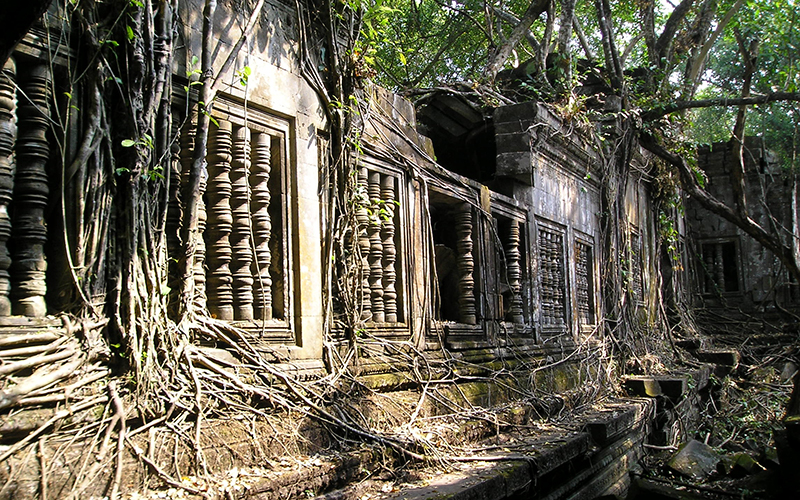 |
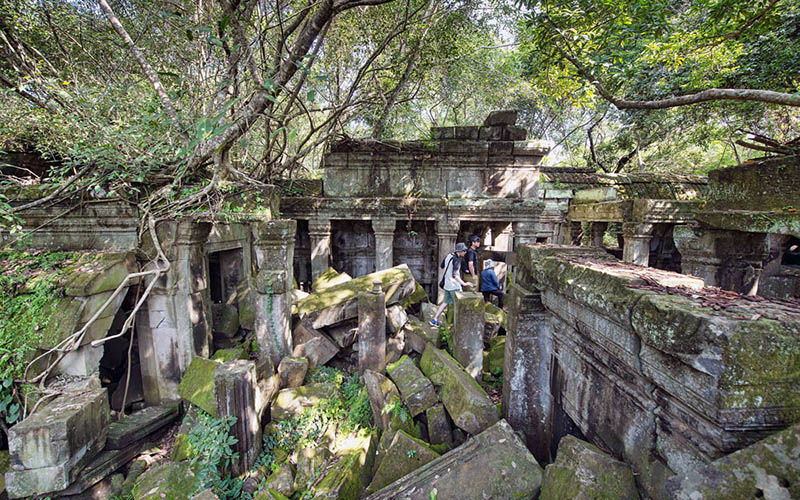 |
Cambodia’s so-called "jungle temple"—a mesmerizing ruin where nature has reclaimed the stones, vines snake through collapsed arches, and silence reigns. An unforgettable setting that sparks the imagination of every explorer.
Why Beng Mealea Makes a Magnetic Travel Destination
1. Lost in Time: An Unrestored Adventure
Built in the early 12th century under King Suryavarman II, Beng Mealea was crafted in the grand style of Angkor Wat—but left largely unrestored. This gives it a uniquely wild, untouched allure: crumbling galleries, toppled stones to clamber over, and winding corridors engulfed by brush and roots.
2. Rich Mythology Carved in Stone
Despite centuries of decay, remarkable carvings endure—depictions of legendary scenes such as the Churning of the Ocean of Milk, Vishnu astride Garuda, and dramatic episodes from the Ramayana.
3. Mystery and Scale
Enclosed by a vast moat (roughly 1,025 m by 875 m), this is more than a ruin—it was once the heart of a thriving city. The layout mirrors cosmic symbolism: concentric galleries, cruciform cloisters, and celestial causeways guarded by mythical Naga serpents.
4. A True “Indiana Jones” Experience
You won't find polished, tourist-friendly paths here—just raw, unfiltered exploration. Wooden walkways exist, but wandering freely among the ruins offers a sense of discovery that few other sites can match.
5. Perfect Light for Photography & Ambiance
Visiting in the early morning (7–9 AM) offers serene solitude and soft lighting; late afternoon delivers dramatic “golden hour” shadows that illuminate the jungle’s embrace.
6. Easy Access, Off-the-Beaten-Path
Located about 40–70 km east of Angkor and roughly 1.5 hours from Siem Reap, Beng Mealea remains peaceful thanks to its distance from the main temple circuit. A tuk tuk or private car through quiet countryside adds to the adventure.
6. Koh Ker Temple
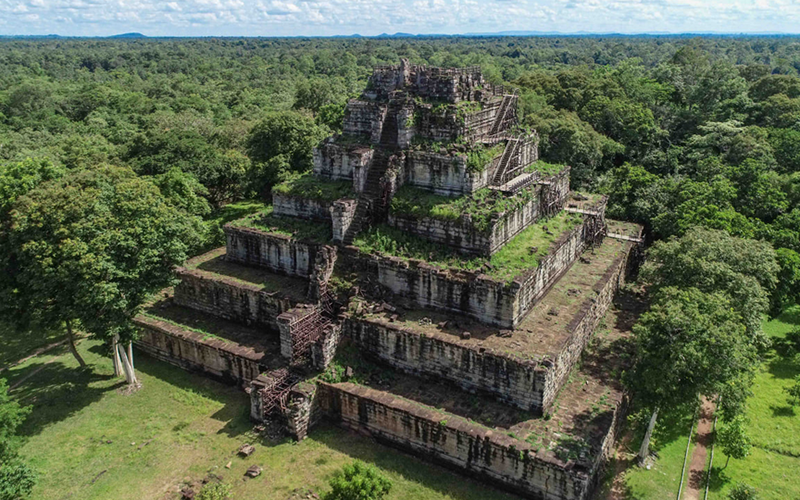 |
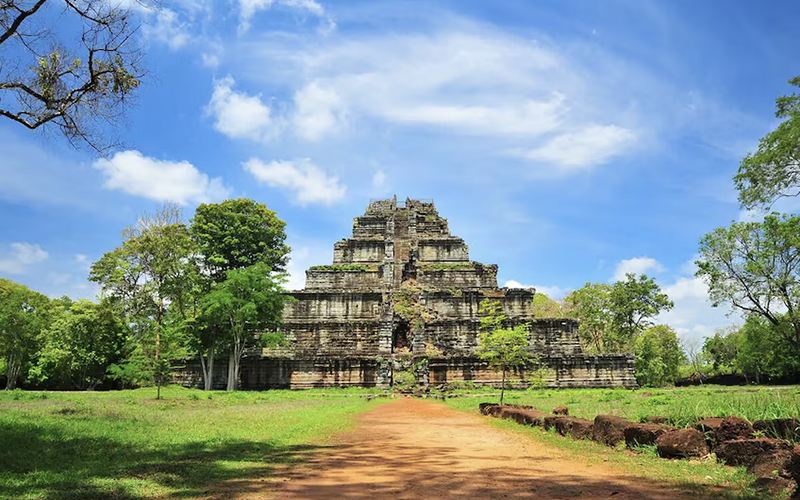 |
Koh Ker—a hidden gem rising from the dense Cambodian jungle, crowned by its iconic stepped-pyramid and ancient sanctuaries waiting to be discovered.
What Makes Koh Ker Uniquely Captivating
1. A Brief but Bold Royal Capital
Koh Ker served as the Khmer Empire’s capital from 928 to 944 CE under King Jayavarman IV before the court returned to Angkor
In that short time, the king initiated a prolific building spree—erecting a vast reservoir, nearly 40 monumental structures, and ambitious religious complexes
2. The Pyramid That Defies Angkorian Norms
At its heart stands Prasat Thom, a seven-tiered pyramid reaching 36 meters tall, a design that diverges sharply from the horizontal layouts of traditional Khmer temples
This vertical marvel is truly unique in Southeast Asia and offered symbolic access to Mount Meru—the cosmic center in Hindu cosmology
3. Enigmatic Charm of the Jungle
Unlike Angkor’s polished grounds, Koh Ker remains largely overgrown and un-restored, combining jungle mystique with archaeological intrigue.
Its remote location also means fewer visitors—an immersive, near-solitary exploration into the heart of history.
4. Ancient Water Works & Sacred Rituals
The site's urban layout showcases advanced water engineering: a massive Rahal baray and a network of around 200 ponds highlight how water was managed for both everyday life and sacred ceremonies.
Innovatively, rainwater was channeled over lingas—sacred Shiva symbols—to sanctify it before reaching ritual basins.
5. A Distinctive Artistic Identity
Koh Ker ushered in an expressive architectural and sculptural style—figures appear more robust and dynamic than elsewhere in Khmer art.
Iconic carvings like the Garuda, larger-than-life lingas, and vibrant temple guardians illustrate a unique aesthetic evolution.
6. Newly Enshrined as a UNESCO World Heritage Site
In September 2023, Koh Ker was officially inscribed as Cambodia’s fourth UNESCO World Heritage Site, joining Angkor, Preah Vihear, and Sambor Prei Kuk. This opens doors for conservation, sustainable tourism, and global recognition
Adventure-Ready Visitor Tips
- When to go: Morning visits offer cooler temperatures and a more solitary experience.
- How to reach: About 120–130 km northeast of Siem Reap (~2.5 hours by road)
- Enhance your exploration: Combine your trip with nearby sites like Beng Mealea or Preah Vihear for fuller context and adventure
- Journey respectfully: Hiring a local guide enriches storytelling where signage is sparse.
7. Preah Vihear Temple
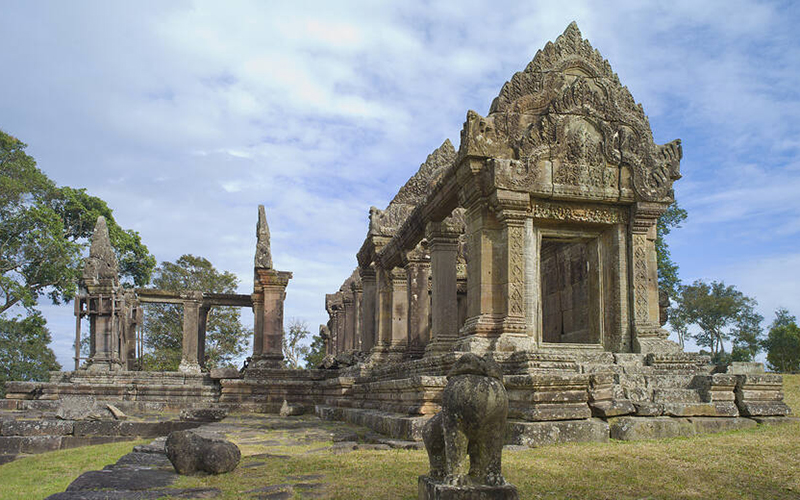 |
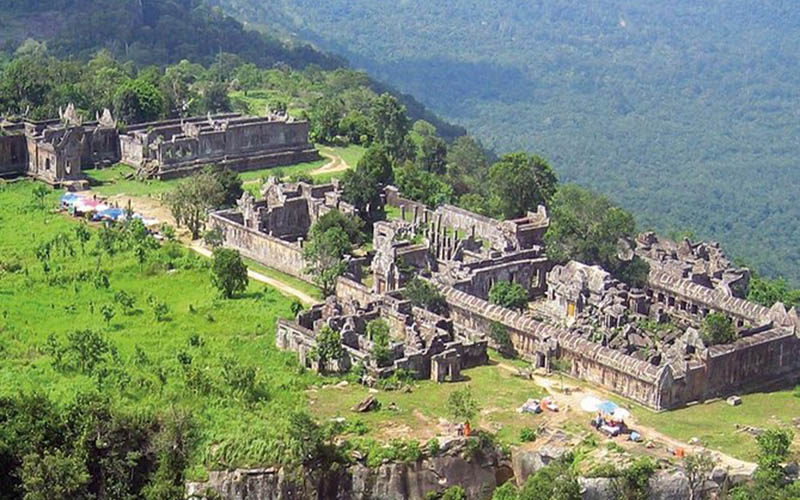 |
Preah Vihear Temple—an extraordinary Khmer masterpiece perched dramatically atop a cliff, offering sublime views and a journey through centuries of spiritual heritage.
Why Preah Vihear Temple Becomes a Must-Visit Destination
1. Cliffside Majesty & Breathtaking Vistas
Suspended high on a 525-meter high cliff in the Dângrêk Mountains, Preah Vihear delivers not just architectural wonder, but a heart-stopping panorama of Cambodia's northern plains—especially magical at sunrise or sunset, casting golden light across its sandstone silhouette
2. Unique Linear Design & Spiritual Ascent
Unlike many Khmer temples, Preah Vihear unfolds along an 800-meter north–south axis, guiding visitors through successive sanctuaries and gopuras in a sacred climb that mirrors spiritual elevation toward Mount Meru—the mythical abode of the gods
3. Masterful Architecture & Mythic Carvings
Every stone tells a story—from intricately carved lintels and bas-reliefs to serene libraries and imposing gates. The craftsmanship, purity of design, and elevated decoration make it a pinnacle of Khmer artistry.
4. Sacred Legacy & Royal Devotion
Dedicated to Shiva, the temple served as a spiritual symbol and political statement. Built between the 9th and 12th centuries under multiple Khmer kings, it embodied royal power rooted in divine association.
5. UNESCO World Heritage & Resilient Identity
Registered in 2008 as a UNESCO World Heritage Site, Preah Vihear stands as an architectural marvel seamlessly integrated into its extreme terrain. The designation elevated its cultural value and cemented Cambodia’s sovereignty amid historical disputes.
6. A Site Laden with History & Tension
Situated along the Cambodia–Thailand border, Preah Vihear’s geopolitical role adds layers of history and emotion. While the International Court of Justice affirmed Cambodia's sovereignty in 1962, tensions linger, making the temple not just a cultural landmark, but a symbol of resilience and identity
8. Kbal Spean -A Journey for the Soul
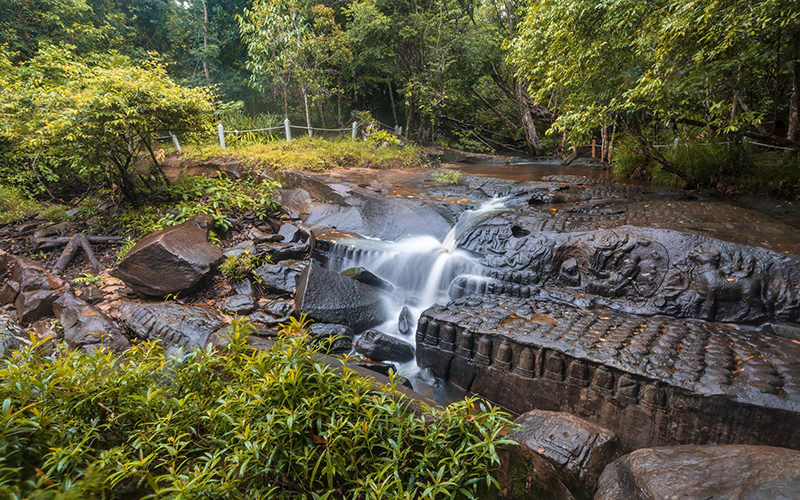 |
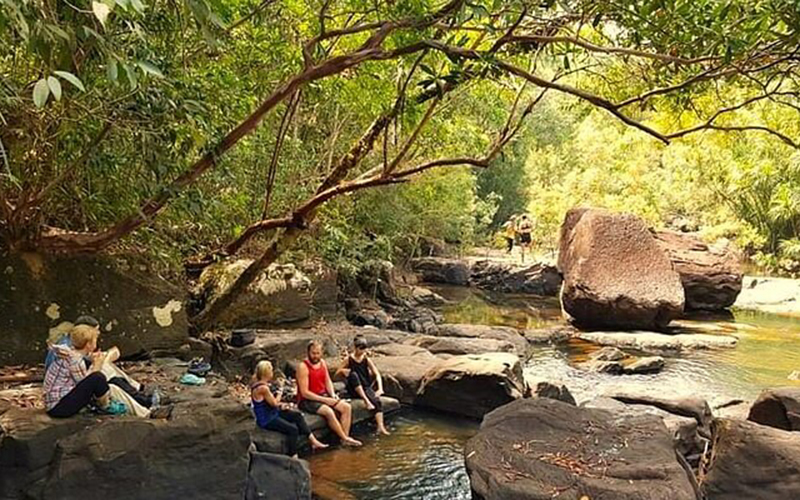 |
Imagine trekking under emerald canopies, arriving at a tranquil river whose waters whisper ancient stories. There, sunlight sparkles over delicate stone carvings—lingas and deities—flowing with the gentle rush of time. Kbal Spean is not merely seen—it’s felt, experienced, and remembered as a sacred tapestry where art and nature flow together.
Kbal Spean, the "River of a Thousand Lingas,"—a sacred Angkorian site tucked into the lush hills of Phnom Kulen that blends art, nature, and ritual into a uniquely immersive journey.
What Makes Kbal Spean Unforgettable
Sacred Riverbed Sculpture
Beneath the flowing waters, over a 150-meter stretch, the riverbed is adorned with hundreds of stone-carved lingas—phallic symbols of Shiva—arranged in perfect grids and mandala-like patterns. Each linga contributes to a ritual blessing as the water flows, nourishing downstream lands and rice fields.
Mythic Stone Reliefs Raised from Water
Alongside the submerged carvings, you'll encounter vivid bas-reliefs of Vishnu reclining on the serpent Ananta (with Brahma emerging on a lotus and Lakshmi nestled at his feet), Shiva and Uma riding the bull Nandi, Hanuman, and other Hindu deities—with many details revealed only when water levels drop.
A Pilgrimage through Jungle Silence
Accessed by a 1.5 km forest trail from the parking area, the trek invites you into a serene jungle sanctuary where birdsong, butterflies, and sunlight filtering through foliage accompany your path to wonder.
Living Heritage Woven into Nature
Carvings created by hermits under the reigns of Kings Suryavarman I and Udayadityavarman II in the 11th–12th centuries endure as sanctified art—the river itself deemed holy by locals, who believe its waters are spiritually charged as they flow over the lingas.
A Hidden Marvel in the Angkor Mountains
Often overlooked, Kbal Spean offers a tranquil and reflective alternative to busier temples—inviting visitors to connect with a softer, more intimate side of Cambodia’s rich heritage.
9. Battambang
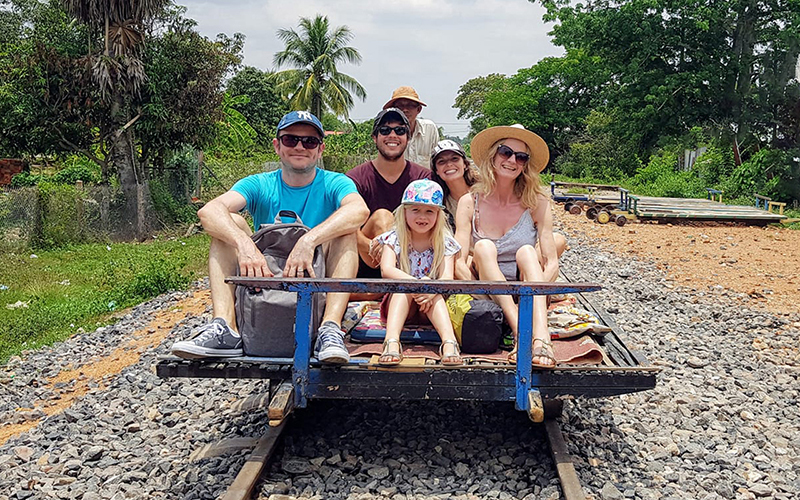 |
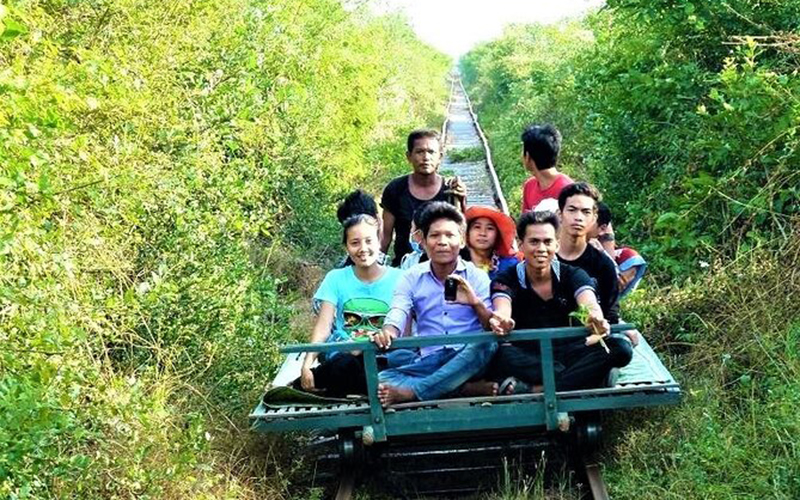 |
Explore the soulful charm of Battambang, Cambodia’s creative riverside jewel, where history, art, gastronomy, and rural life harmoniously converge. Unearth a city humming with authenticity and cultural resonance.
Why Battambang Captivates Travelers
Heritage in Every Corner
Breathe in the elegance of French colonial architecture—from graceful villas to art-deco facades in the city center—where colonial heritage meets Khmer aesthetics.
Endless Creative Energy
Known as Cambodia’s artistic heartbeat, Battambang boasts galleries like Romcheik 5 and heartwarming street murals that speak of local life, history, and hope. The city is also home to Phare Ponleu Selpak, a dynamic circus and arts school where powerful performances uplift communities.
Rural Rhythm & Rice-Field Reverie
Cycle or kayak through emerald rice paddies, stilted villages, and riverside serenity to connect with timeless Cambodian landscapes. Witness traditional crafts—like rice-paper making and prahok preparation—unfolded by skilled hands.
Thrills, Tradition & Temples
Hop aboard the quirky Bamboo Train for a whimsical ride through the countryside. Climb to Wat Banan, the “mini Angkor,” for panoramic views, or explore the atmospheric Ek Phnom ruins and Phnom Sampeau—where sacred caves, bats, and history converge.
Culinary Creativity
In 2023, Battambang earned a spot on UNESCO’s Creative Cities Network for gastronomy—thanks to its jasmine rice, vibrant street food, and bold culinary legacy. Dive into local flavors like amok, rice noodles, and seasonal delights.
Deep Memories & Authentic Markets
Stroll through morning markets like Brahok Fish Market to experience local bustle firsthand. For history-seekers, Wat Samraong Knong offers peaceful reflection with its memorial halls and traditional pagoda beauty
10. Phnom Penh
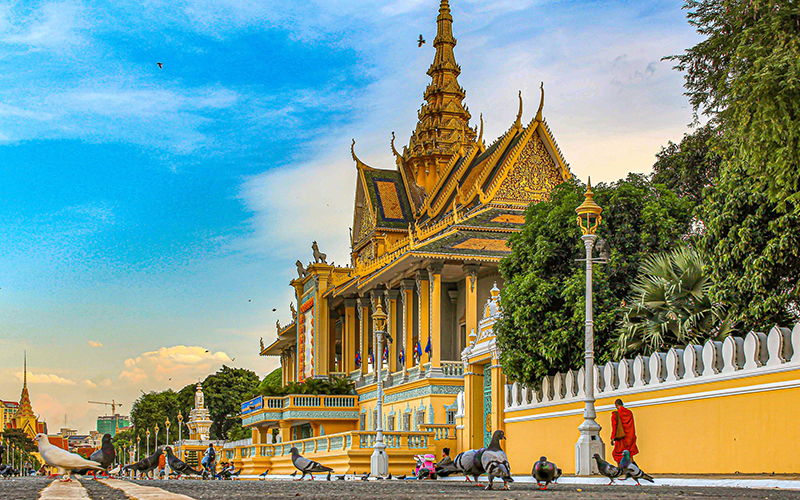 |
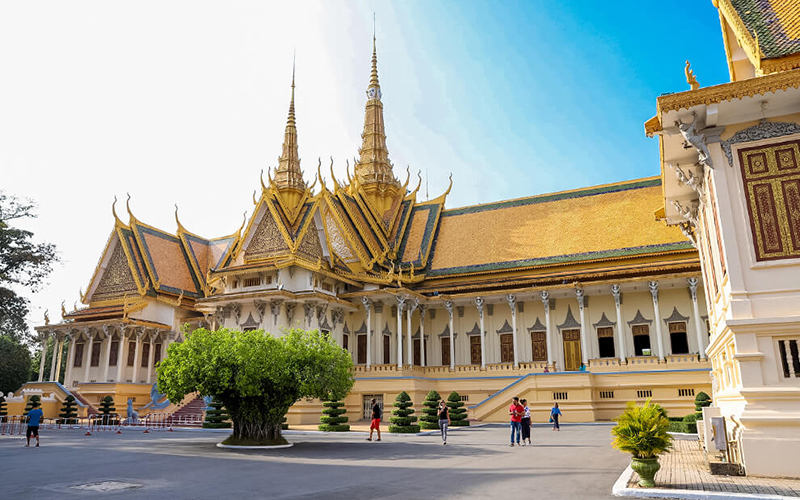 |
Discover the magic of Phnom Penh as a city of contrasts—where soaring royal architecture meets lived-in markets, and serene river vistas stand beside poignant reminders of history.
Begin at the Royal Palace & Silver Pagoda
Marvel at opulent relics: the crystal-green “Emerald Buddha”, a 90 kg gold Maitreya set with diamonds, and Reamker murals—all set within regal palace grounds.
Honor memory at Tuol Sleng and the Killing Fields
Walk through S-21’s cold cells and reflective exhibits, then venture to the haunting grounds of Choeung Ek—spaces that carry the quiet weight of Cambodia’s recent past and shine a path toward resilience.
Stroll the vibrant Central and Russian Markets
Step into vivid, sensory worlds. The art-deco Central Market dazzles with jewelry, fabrics, and flowers under its yellow dome; at the Russian Market, haggle your way through treasures and street snacks in a lively local maze.
Feel the city’s pulse along Sisowath Quay
This riverside promenade, lined with cafés and colonial buildings, is the perfect avenue for sunset walks, people-watching, or unwinding beside the Tonlé Sap.
Climb to Wat Phnom and soak in the legend
Perched atop the city’s only hill, the temple survives as a spiritual and mythic heart of Phnom Penh—its origin story intertwines with the very founding of the city.
Experience Phnom Penh by tuk-tuk and on foot
Let tuk-tuks whisk you through city lanes, then slow down to wander café-studded neighborhoods, boutique shops, and hidden art spots—perfect for uncovering Phnom Penh’s authentic layers.
Drift into evening with a river cruise
Cap off your exploration with a tranquil Mekong sunset cruise—complete with live music or cultural performances, and panoramic views of the city lights
11. Discover Sihanoukville: Cambodia’s Coastal Gem
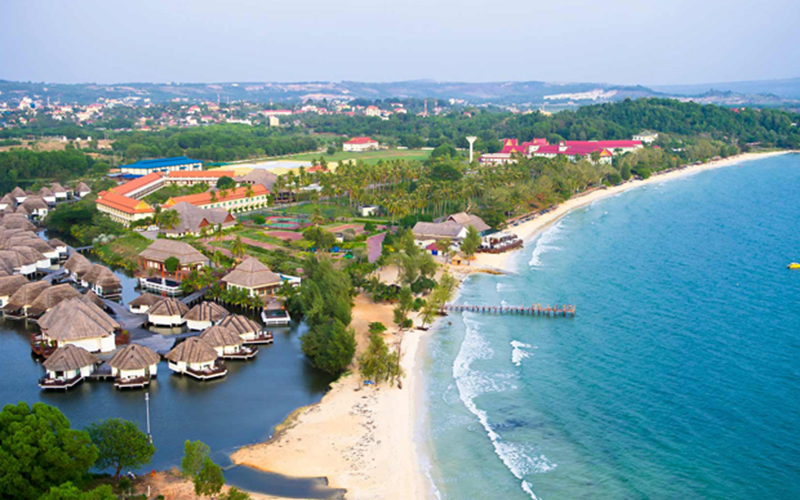 |
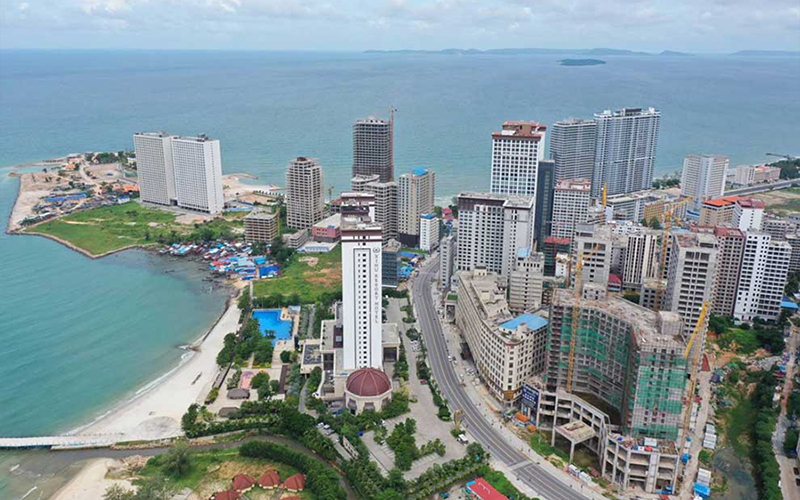 |
Sun-Kissed Beaches & Island Escapes
Nestled along the Gulf of Thailand, Sihanoukville offers a mesmerizing array of sun-drenched shorelines—each with its own mood. From the tranquil stretch of Otres Beach, perfect for laid-back strolls and sunset gazing, to the more accessible Sokha Beach, known for its calm waters and optional water sports like snorkeling, kayaking, and SUP.
But the real slice of paradise lies just a boat ride away. Venture to Koh Rong and Koh Rong Samloem to discover powdery white sands, azure waters, and the island seclusion that dreams are made of.
Nature’s Hidden Retreats
Escape the beach for a moment of inland wonder at Kbal Chhay Waterfall, nestled under a canopy of greenery just a short drive from town. Its cascading waters and verdant setting offer a refreshing interlude to seaside bliss.
Cultural Colors & Market Rhythms
Immerse yourself in the authentic pulse of local life at Phsar Leu Market—a lively bazaar overflowing with fresh produce, exotic fruits, spices, and handmade treasures. Bargain, sample street food, and soak in the sensory symphony of sights and sounds.
Temples with a View
Climb the gentle slopes to Wat Leu Temple, a hillside sanctuary offering sweeping vistas of coastline and town. Or visit St. Michael’s Church, a rare surviving gem of New Khmer architecture by renowned architect Vann Molyvann—a unique spiritual stop with historical depth.
Go Beyond the Beaten Track
Discover the soul of the region through village visits and hidden landscapes. Explore rural Khmer life, stroll mangrove trails, and even glimpse wild monkeys near Independence Beach. For those craving nature’s quiet secrets, nearby caves with jungle pools and cliffside shrines await exploration—quiet delights few tourists ever experience.
Flavors of the Coast
Savor fresh seafood—from grilled squid to Khmer-style curries—served with coastal charm. Beachfront eateries serve springy noodles, succulent crabs, and ocean-kissed flavors that highlight Cambodia’s culinary simplicity.
Bliss in Transformation
Sihanoukville stands at a crossroads—where rustic charm meets modern reinvention, and where quiet beaches exist alongside burgeoning development and cultural evolution.
12. Enchanting Kampot & Kep: A Tale of Spice, Sea, and Serenity
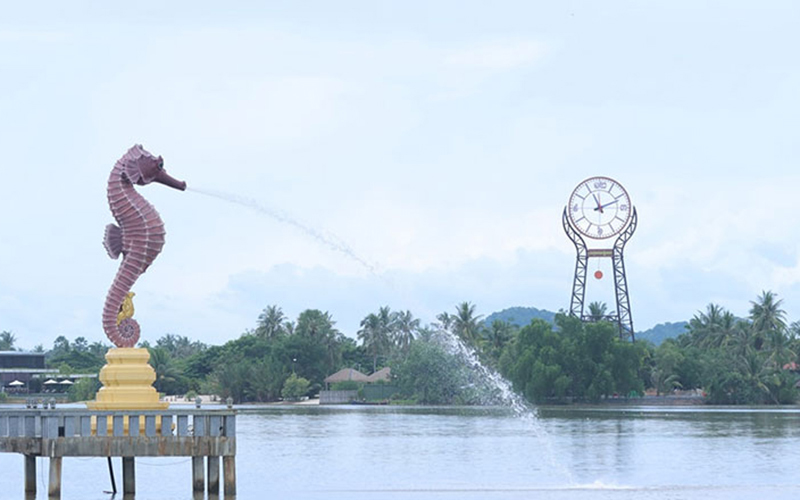 |
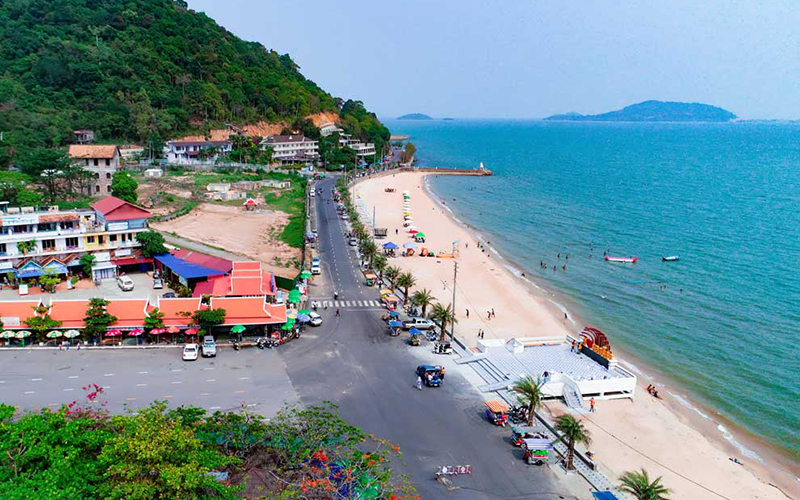 |
1. Kampot: Where Time Slows Down
Nestled beside the peaceful Kampot River, this historic town whispers of a colonial past through its elegant French era facades and laid back streets. Every corner — from the Old Market to the Night Market — invites discovery, offering local crafts, delicious snacks, and intriguing architecture.
2. Savor the World Renowned Kampot Pepper
A visit to a pepper plantation—be it La Plantation, Bo Tree, or Sothy’s—is a sensory journey through fragrant vines, organic farming, and tasting sessions that reveal why Kampot Pepper is cherished globally and holds Protected Geographical Indication status. Explore winding dirt roads, past sugar cane fields and rustic villages, culminating in the hidden gem of Secret Lake—a serene break from the crowds.
3. Salt Fields & Sunset Cruising
Vast white salt flats—where ocean water evaporates to form crystal mounds—offer a surprisingly picturesque detour, especially striking later in the day. End your Kampot day with a dazzling sunset cruise or tranquil firefly river journey on the Kampot River. Feel nature’s nightly rhythm as flickering fireflies scatter along the jungle-fringed water.
4. Bokor Hill’s Mystery & Majesty
Ascend into history and mist atop Bokor Mountain, home to eerie yet captivating colonial relics—ruins like the Black Palace, Buddhist temples, Bokor Palace, and a hauntingly beautiful Catholic church—all floating in an atmosphere of nostalgia and panoramic coastal views.
13. Kep: Coastal Grace Meets Culinary Delight
 |
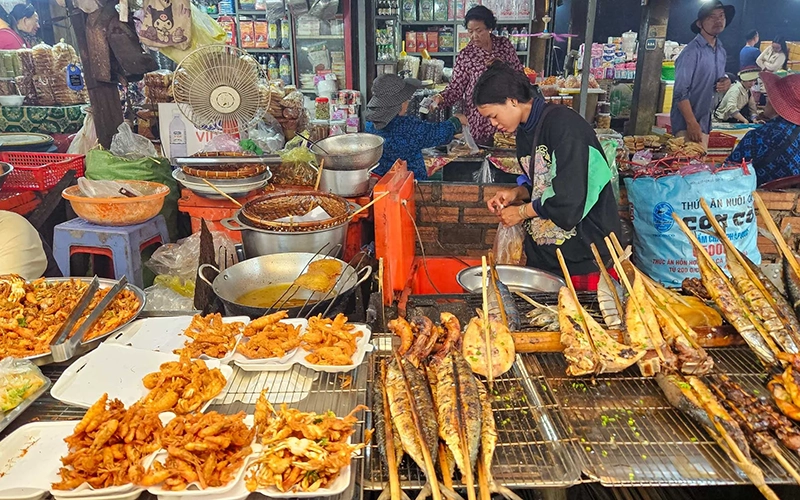 |
1. Crab Markets Under the Sea Breeze
Wake up early to the iconic Kep Crab Market, alive with fishermen hauling in fresh blue crabs and vendors grilling them instantly. Dive right into the culinary action—buy your seafood and have it cooked fresh at the stall of your choice.
2. Rest, Hammocks & Rabbit Island
Stroll along the short, sandy stretch of Kep Beach with its laid-back groove—hammocks, coconut vendors, charming cafés, and the occasional kayak glide. Beyond the beach, a 30-minute boat ride delivers you to Rabbit Island (Koh Tonsay)—a blissfully undeveloped escape ideal for hammocking, swimming, or simply unwinding.
3. Kep National Park Trails & Panoramas
Take a short hike through Kep National Park to discover verdant paths, lookout points revealing the coastline and distant islands, and the gentle echo of forest life.
4. Epicurean Fusion: Pepper Meets Crab
Indulge in Kampot Pepper Crab, the region’s signature stir-fry specialty—combining crab, garlic, palm sugar, fish sauce, spring onions, and fresh green Kampot peppercorns. Every bite is a harmonious blend of local flavor and coastal freshness




